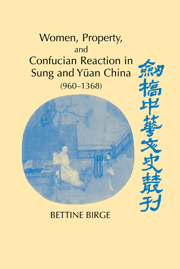Book contents
- Frontmatter
- Contents
- List of Maps, Figures, and Tables
- Chronology of Chinese Dynasties
- Abbreviations
- Acknowledgments
- Introduction
- 1 Women and Property before the Sung: Evolution and Continuity
- 2 Women and Property in the Sung: Legal Innovation in Changing Times
- 3 Women's Property and Confucian Reaction in the Sung
- 4 Transformation of Marriage and Property Law in the Yüan
- Conclusion: Gender, Mongols, and Confucian Ideals
- Bibliography
- Glossary-Index
1 - Women and Property before the Sung: Evolution and Continuity
Published online by Cambridge University Press: 24 August 2009
- Frontmatter
- Contents
- List of Maps, Figures, and Tables
- Chronology of Chinese Dynasties
- Abbreviations
- Acknowledgments
- Introduction
- 1 Women and Property before the Sung: Evolution and Continuity
- 2 Women and Property in the Sung: Legal Innovation in Changing Times
- 3 Women's Property and Confucian Reaction in the Sung
- 4 Transformation of Marriage and Property Law in the Yüan
- Conclusion: Gender, Mongols, and Confucian Ideals
- Bibliography
- Glossary-Index
Summary
From earliest times for which records survive, we find a remarkable continuity of concepts and practices that governed women's relations to property over the centuries. Sung practices, discussed in the next chapter, must be understood within this long tradition. In essence, the bonds of blood for daughters as well as sons carried with them a certain expectation of material support, commensurate with the wealth of the parents. Thus despite long-term political and social evolution that dictated considerable changes in forms of property, marriage laws, and inheritance patterns, certain basic contours of women's property rights can be discerned in almost every age before the Sung. Sung laws also, while new in many respects, did not contradict these. These contours included several key points: (1) A woman of nonservile status could expect to marry with dowry property attached to her. (2) A married daughter might receive additional property from her parents sometime after the marriage on top of her previous dowry portion. (3) Within marriage, a wife's property was conceptually distinct from that of her husband. Although the husband or his family invariably benefited directly or indirectly from the wife's property, it was her own in that she could take it with her out of the marriage in case of divorce or widowhood. (4) In the absence of sons, daughters married or unmarried, stood to inherit all of their parents' estate.
- Type
- Chapter
- Information
- Publisher: Cambridge University PressPrint publication year: 2002

